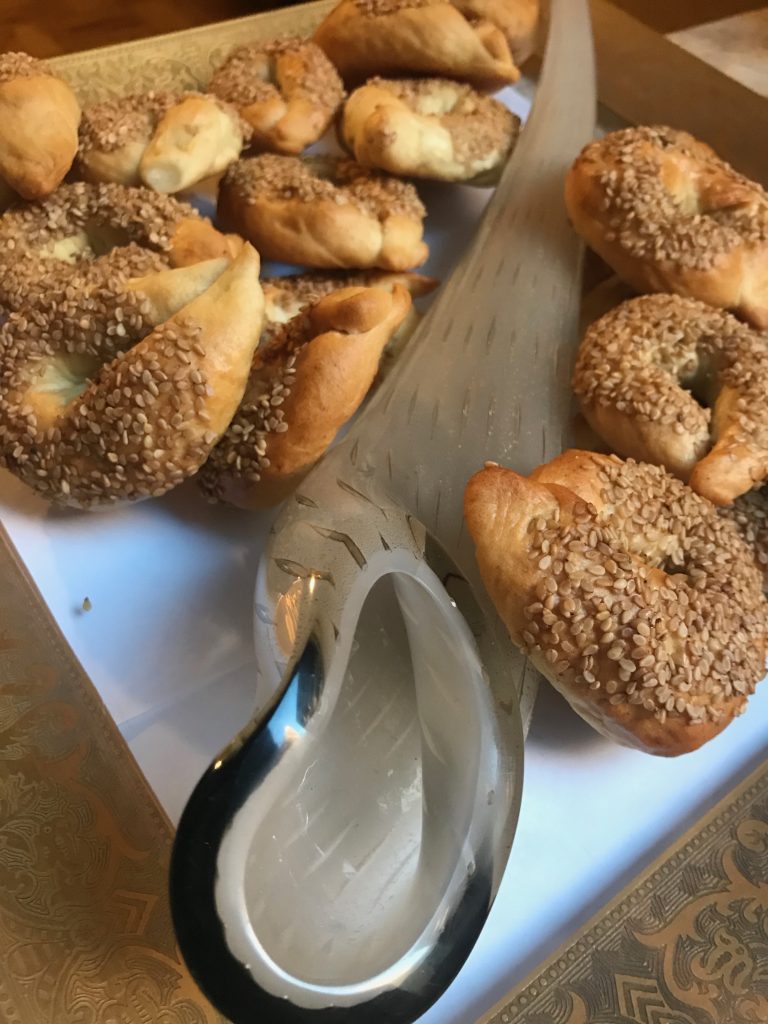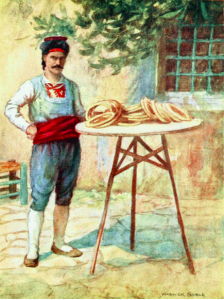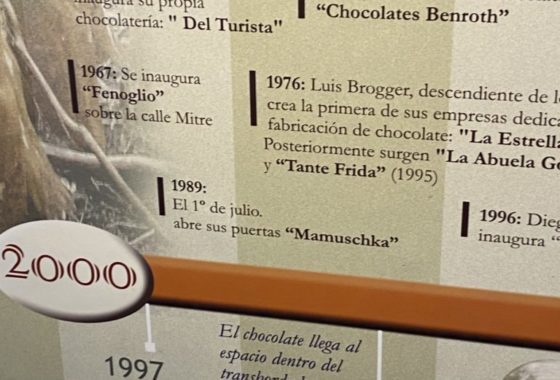
Kaak: Recipe for Crunchy Yeast Biscuits
Eat kaak all year round or save them for special celebrations, as do many communities of the Middle East and Sephardim (Jews descended from Spain). Kaak (kahk, ka’ak) are ubiquitous, multi-faith and multi-cultural doughy treats eaten throughout the Middle East where they take on regional flavors. In Arabic kaak means cake or baked good.The Egyptian poet, Fouad Haddad, rhapsodizes about their popularity, “Oh kahk, master of generosity … we will never stop making you.”
In East Jerusalem kaak may be topped with zaatar spice mix. Iraqis flavor with fenugreek. Egyptians with coriander and they sometimes enhance them with raisins, almonds, and/or apples. Yemeni and Jordanian versions are briochy. In Morocco, the roundness of the kaak recalls the shape of the sun; there they might be flavored with some combination of cardamom, fennel, anise, cinnamon, and almonds. They are often named with a hometown place of origin. In Lebanon, kaak bi semsin are shaped like pockets or purses. Another version kaak bee haleeb with milk is preferred during Easter. Egypt also has loz bi kahk with almonds for weddings and engagements. Somalia’s spicey kaak are cut into squares or rectangles with a briochy texture as well.

Simit Seller from Constantinople published in London, 1906 painted by Warwick Gobles. Project Gutenberg ebook
Sometimes they are shaped with lovely wooden maamul or mounash molds. In some locations or if the baker is in a hurry, they might take the shape of bread sticks since the making of the rounds takes more time. When they are filled with dates or nuts, they are known as maamoul.
Christians enjoy kaak at Easter and Christmas; Muslims at Eid al Fitr, the celebration at that concludes the Ramadan fast. For Christians, they came to represent the shape of Jesus’s crown of thorns. At the end of Ramadan, women gather to fashion the circular shapes with duties divided up for kneading, cutting, and shaping. Muslims use a yellow coloring to honor the deceased by giving kaak to the poor, to children, and to relatives on the weekly Thursday of the dead.
Enjoy this recipe for kaak, a crackery bread for all seasons and for all peoples.
Prep time: 1 hour
Rising time: 2 hours and 20 minutes
Baking time: 40 minutes
Yield: about 50 rings
adapted from Encyclopedia of Jewish Food by Gil Marks
INGREDIENTS
1 package or 2 ¼ teaspoons dry yeast
1 ⅓ cups warm water (105-115º F) this includes the ¼ cup used with the yeast mix
1 teaspoon sugar or honey
½ cup vegetable oil or shortening
1 ½ teaspoon table salt or 1 tablespoon kosher salt
1 tablespoon ground anise
pinch of mahlab spice (optional)
4 cups, approximately unbleached all purpose flour
1 large egg beaten with 1 tablespoon water for wash in a flat bowl
½ – 1 cup sesame seeds in a flat bowl for the topping
INSTRUCTIONS
1. Dissolve the yeast in ¼ cup of the water. Stir in the sugar (or honey) and let stand until foamy, 5 to 10 minutes. In a large bowl, combine the yeast mixture, remaining water, oil, salt, anise, mahlab, and 2 cups flour. Gradually add enough of the remaining flour to make a mixture that holds together.
2. On a lightly floured surface or plastic mat, knead the dough until smooth and elastic, 10-15 minutes. Place in an oiled bowl and turn to coat. Cover loosely with plastic bag and let rise in a warm, draft free space until doubled in size, approximately 2 hours.
3. Line 2 large baking sheets with parchment paper or lightly grease the pans. Deflate the dough and divide it into 1-inch balls. While working on some of them, leave the others under the plastic bag. On a flat surface roll the balls into ½ inch-thick-ropes about 5 inches long. Bring the ends together to form a ring and pinch to seal. Dip the top of the ring into the egg wash and then into the sesame seeds. Place onto the baking sheets with sesame side facing up, allowing space between each ring. Cover with plastic bag and allow to rise for 20 minutes. In the meantime preheat the oven to 375º F.
4. Bake for about 20 minutes and remove from oven.
5. Lower the heat to 225º F. Then return the kaak to the oven, rotating the pans, and bake until crisp, but not extremely hard, about 20 minutes.
6. Transfer to a wire rack and let cool completely. Store in airtight containers or in the freezer, well wrapped.
Rabbi’s Remarks:
1. I would try adding 1-1 ¼ teaspoon ground fennel and or cumin and or increase the amounts of the spices above for even more flavor. Marks suggests instead of ground anise, use 3 tablespoons anise seeds or 2 tablespoons anise seeds and 1 tablespoon ground seeds. I avoid the seeds because my grandchildren don’t like them.
2. Mahlab is a western Asian spice made from the ground soft kernels of a wile cherry. Sift before using it as it tends to get lumpy. The name is based on a Lebanese town mentioned twice in the Bible.
3. Marks gives the option of using 3 ½ cups of flour plus ½ cup of semolina, regular or fine. He also suggests that to sweeten these into biscochos, add ½ cup sugar to the dough.
Learn more about the chocolatebabkaproject.
2 thoughts on “Kaak: Recipe for Crunchy Yeast Biscuits”
Leave a Comment
Recent Posts
-
On the Chocolate Trail in Bariloche, Argentina
In March, Mark and I finally extended our chocolate trail explorations in celebration of our special anniversary to Bariloche…via Miami, Buenos Aires, Ushuaia, Antarctica, and Buenos Aires again. There were international flights, a cruise, a couple of domestic flights to get there. All of the travel was amazing, but Bariloche, sometimes called the chocolate capital
Read more › -
Sunday Yeast Polemics: On the Bread Trail
Leavened bread or not? While some of us may think of Passover, the question applied to Eucharistic bread and created significant division in the early Christian Church. The leavened bread for Sunday use was often baked at home by women. Over time, preferences shifted to clergy, church-produced, breads… and, the Eastern Orthodox Church preferred a
Read more › -
Sweet Treat: Chocolate and the Making of American Jews
You may wonder: how did chocolate help define American Jews? Through chocolate, we see that Jews were part of America since its earliest days. Well, since 1701 at least, Jews in the Colonies made part of their living through chocolate. Several Sephardim, leaders of their New York and Newport Jewish and secular communities, participated in
Read more › -
How About Some Uterus Challah?
When Logan Zinman Gerber felt enraged about the loss of reproductive rights in the U.S., she baked challah. Not any challah. She shaped it into a uterus. It wasn’t long after the birth of her daughter that Gerber, a longtime challah baker and staff member of the Religious Action Center of the Reform movement, considered
Read more ›
Some Previous Posts
(in alphabetical order)
- "Boston Chocolate Party" Q&As with Deborah Kalb
- 2022 Media for The "Boston Chocolate Party"
- A Manhattan synagogue explores the rich, surprising history of Jews and chocolate
- About Rabbi Deborah Prinz
- Baking Prayers into High Holiday Breads
- Boston Chocolate Party
- Digging into Biblical Breads
- Exhibit Opens! Sweet Treat! Chocolate & the Making of American Jews
- For the Easiest Hanukah Doughnuts Ever
- Forthcoming! On the Bread Trail
- Funny Faced Purim Pastries
- Good Riddance Chameitz or, The Polemics of Passover's Leaven
- How About Some Uterus Challah?
- Injera*
- Jewish Heritage Month: Baseball & Chocolate!
- Matzah - But, the Dough Did Rise!
- Plan a Choco-Hanukkah Party: 250th Anniversary Tea Party
- Prayers Into Breads
- To Shape Dough: A Trio of Techniques
Archives
2025
▾- All
2024
▾- January
- February
- March
- May
- July
- All
2023
▾- March
- April
- May
- June
- August
- November
- December
- All
2022
▾- February
- April
- November
- December
- All
2021
▾- March
- April
- October
- November
- All
2020
▾- April
- May
- June
- October
- December
- All
2019
▾- January
- February
- April
- May
- July
- August
- September
- October
- December
- All
2018
▾- February
- March
- April
- May
- July
- September
- October
- November
- December
- All
2017
▾- January
- February
- March
- July
- September
- October
- November
- December
- All
2016
▾- January
- February
- March
- May
- July
- August
- October
- November
- All
2015
▾- January
- February
- March
- May
- June
- July
- September
- November
- All
2014
▾- February
- April
- May
- June
- August
- September
- November
- All
2013
▾- March
- April
- May
- June
- July
- September
- November
- All
2012
▾- January
- February
- March
- April
- September
- October
- November
- December
- All
2011
▾- April
- July
- August
- October
- November
- All
2010
▾- January
- February
- April
- July
- August
- September
- October
- All
2009
▾- January
- June
- July
- August
- October
- All
2008
▾- August
- September
- October
- November
- All
2007
▾- January
- June
- July
- All
2006
▾- November
- December
- All




Nice painting.
Originally the ring was build with a braid made with 2 twisted long cylinders of dough.
The painting remember me that the bakeries use to tie the ka’aks with a cord.
They are great soaked in Turkish coffee or milk with chocolate or coffee.
I bake them between 160C-170C watching that they don’t overcook (burn).
I like this site, this is the first time that a search hits it.
You may need to do something to make it more visible for the searchers maybe the way to mark with keywords, I don’t know what, but you started by 2006 and no search showed me this site before this time. I use the web since the middle 1990s.
Where are you located and where did you learn to make kaak? Have you ever seen kaak used as a decoration?